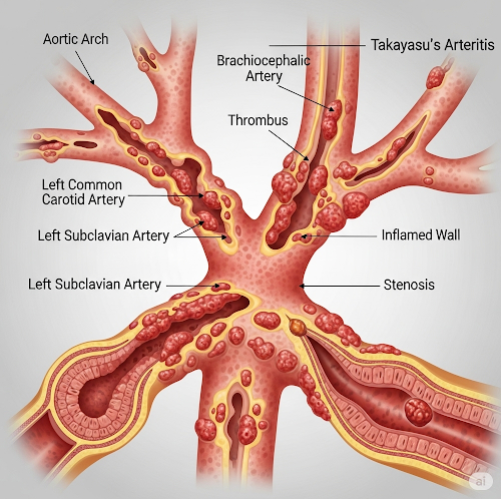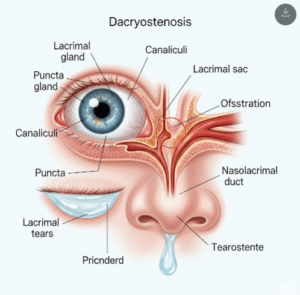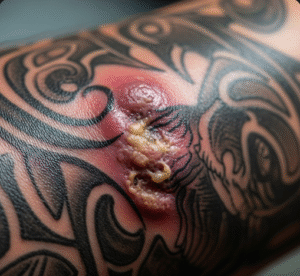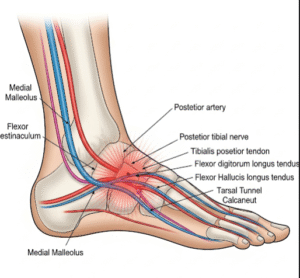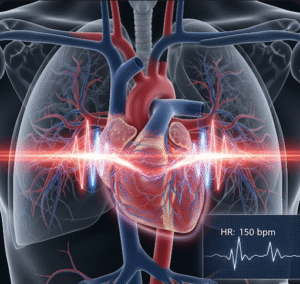Overview
Takayasu’s arteritis (TA) is a rare, chronic inflammatory disease that primarily affects large blood vessels, especially the aorta and its main branches. It causes thickening and narrowing of these arteries, leading to reduced blood flow to organs and tissues. This condition can result in serious complications such as hypertension, stroke, or organ ischemia. Although rare globally, awareness and diagnosis of Takayasu’s arteritis have improved in Korea, with advanced imaging technologies and specialized rheumatology services providing timely and effective management.
What is Takayasu’s Arteritis?
Takayasu’s arteritis is a form of large-vessel vasculitis that involves inflammation of the aorta, its primary branches, and sometimes the pulmonary arteries. The disease causes granulomatous inflammation, which thickens the arterial walls, leading to stenosis (narrowing), occlusion, or aneurysm formation. TA predominantly affects young women under 40 but can occur in all ages and genders. The exact cause is unknown, but it is believed to be an autoimmune disorder triggered by genetic and environmental factors.
Symptoms
Symptoms of Takayasu’s arteritis often develop gradually and can be divided into two phases: the systemic (inflammatory) phase and the occlusive phase.
- Systemic phase symptoms:
- Fatigue and malaise
- Low-grade fever
- Weight loss
- Night sweats
- Muscle and joint pain
- Loss of appetite
- Occlusive phase symptoms:
- Claudication (pain and fatigue in limbs during activity due to poor blood flow)
- Decreased or absent pulses, especially in arms (“pulseless disease”)
- Blood pressure discrepancies between arms
- Dizziness or fainting due to reduced brain blood flow
- Hypertension caused by renal artery involvement
- Headaches and visual disturbances
- Chest pain from heart involvement
Causes
The exact cause of Takayasu’s arteritis remains unclear. It is classified as an autoimmune disorder where the immune system mistakenly attacks the blood vessels. Contributing factors may include:
- Genetic predisposition, including certain HLA gene associations
- Environmental triggers such as infections (though no definitive link established)
- Hormonal factors, given its prevalence in young women
Risk Factors
- Female sex, especially aged 10-40 years
- East Asian ethnicity, including Koreans, who have higher reported incidence
- Family history of autoimmune diseases
- Possibly certain infections or environmental exposures
Complications
Without proper treatment, Takayasu’s arteritis can cause:
- Severe narrowing or blockage of major arteries
- Hypertension leading to heart failure
- Stroke or transient ischemic attacks due to reduced cerebral blood flow
- Aneurysm formation with risk of rupture
- Organ ischemia causing kidney damage or limb loss
- Increased risk of cardiovascular events
Prevention
Because the cause is autoimmune and not fully understood, specific prevention strategies for Takayasu’s arteritis are not established. However, early diagnosis and treatment are critical to prevent complications. General recommendations include:
- Regular medical checkups if symptoms suggestive of vasculitis arise
- Prompt evaluation of unexplained systemic symptoms like fever and fatigue
- Managing cardiovascular risk factors such as high blood pressure
- Avoiding smoking and maintaining a healthy lifestyle
Treatment Options in Korea
Korea’s medical system offers specialized care for Takayasu’s arteritis combining immunosuppressive therapies, advanced diagnostics, and interventional procedures:
Diagnosis
- Detailed clinical examination and history taking
- Blood tests indicating inflammation (elevated ESR, CRP)
- Imaging techniques such as CT angiography, MRI angiography, and PET scans to visualize arterial inflammation and damage
- Ultrasound Doppler studies to assess blood flow and vessel wall thickness
Medical Treatment
- Corticosteroids: High-dose steroids are the primary treatment to reduce vascular inflammation.
- Immunosuppressants: Drugs like methotrexate, azathioprine, or mycophenolate mofetil are used as steroid-sparing agents.
- Biologic agents: Targeted therapies such as tocilizumab (IL-6 receptor antagonist) have shown effectiveness in refractory cases.
- Antihypertensive medications: To control blood pressure and reduce cardiovascular risks.
Surgical and Interventional Procedures
- Angioplasty and stenting to open narrowed arteries when necessary
- Vascular bypass surgery in cases of severe occlusion
- Careful perioperative management to control inflammation before surgery
Monitoring and Supportive Care
- Regular follow-up with rheumatologists and cardiologists to monitor disease activity
- Imaging studies to track progression or remission
- Physical therapy and rehabilitation to manage symptoms
- Patient education on medication adherence and lifestyle modifications
Top Korean Medical Centers for Takayasu’s Arteritis
- Seoul National University Hospital
- Asan Medical Center
- Samsung Medical Center
- Severance Hospital (Yonsei University Health System)
These centers provide multidisciplinary teams experienced in managing complex vasculitis cases, combining immunology, cardiology, radiology, and surgery expertise.

